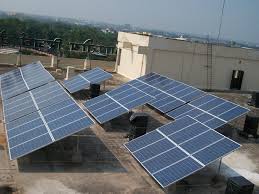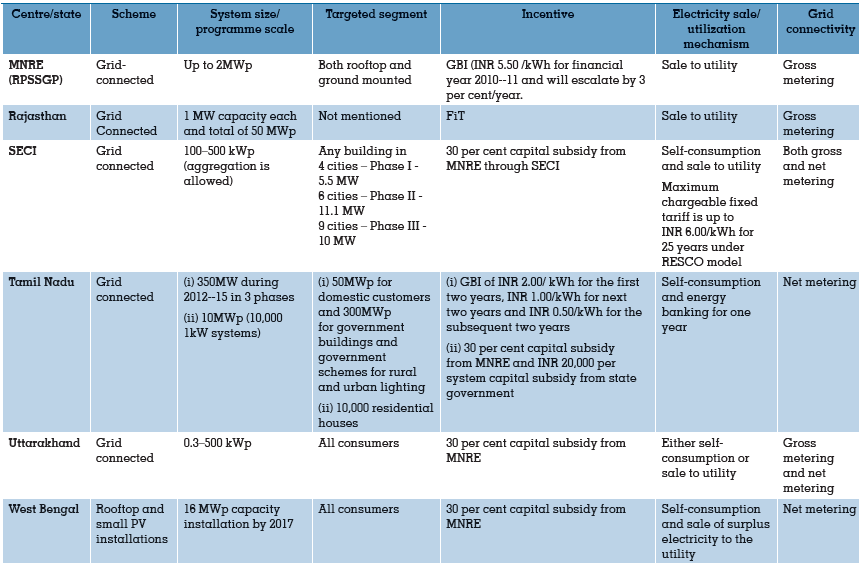Rooftop Solar Policies in different States in India
A target of 40,000 MW of rooftop installations by 2022 has been finalised by India and according to estimates ~70% of the buildings in India are yet  to be constructed by 2030, which shall further widen the scope of solar rooftop deployment across India. Currently only less than 3% of the total installed solar capacity in India is rooftop solar, which shows the immense potential available in this segment.
to be constructed by 2030, which shall further widen the scope of solar rooftop deployment across India. Currently only less than 3% of the total installed solar capacity in India is rooftop solar, which shows the immense potential available in this segment.
The government both at the state and central level has implemented a number of ways to promote rooftop solar in India like capital subsidies, accelerated depreciation, launching the Surya Mitra program, solar cities, various online portals, and empanelling agencies for rooftop installation etc.
There is a 30% capital subsidy from the MNRE for solar rooftop systems on homes, educational institutions, hospitals, etc. States might choose to provide an additional subsidy if required.
Also read about Different Components of Rooftop Solar.
Different Incentives for Rooftop Solar in India that have helped states achieve major milestones
India has adopted both gross and net metering options and recently the Government of India sanctioned INR 5000 crores to boost rooftop solar growth in the country. An Achievement linked incentive scheme was also launched recently by MNRE in May 2016, which promises an incentive on the total project cost, in case the full target is achieved. The Indian Government introduced UDAY, to restructure its power sector. As per this reform, the discom debt will be moved onto the balance sheet of the respective state governments. Since solar power depends heavily upon the distribution system, it is important for such reforms to be implemented. Some of the major breakthroughs achieved/ to be achieved by the Indian states:
- More than 45% of India’s solar capacity have been added by the western states of Gujarat and Rajasthan. Andhra Pradesh, Maharashtra, Karnataka, MP, Telangana and TN are following closely.
- Currently Punjab and Gujarat comprise the largest grid connected rooftop project capacity in the country. Next Tamil Nadu is expected to have the largest of such capacity.
- Maharashtra and Karnataka are expected to install 43% of India’s 40 GW of rooftops by 2022.
- Gujarat was the first state in the country to implement rooftop solar PV pilot scheme.
Net Metering Policy Status across Various Indian State
Andhra Pradesh has the best Solar Power Policy in my view
Andhra Pradesh has emerged out to be one state, where execution can be seen on the ground level. Its solar power policy is one of the best ones in the country, allowing open access and no charges. It also makes regulation and approvals extremely easy, giving time bound approvals and reducing red tape. AP solar policy have been applauded for placing emphasis on rooftop solar projects installed on either commercial and residential rooftops or industrial ones. Customers have been given the option to choose either net or gross metering policies for selling power to the distribution companies.
While the government has set a target of 5000 MW in the next 5 years, I think it will exceed the target much sooner. AP is all set to become the leading solar state, taking over the baton from Rajasthan and Gujarat. The rapid execution and commitment from the top leadership of the government has been the key factor leading to its top position.
Different State and Central policies for Rooftop SPV in India
According to the Government of Delhi, the city has the potential to install 2GW of solar generation capacity by 2025. Infact Delhi has been named as the largest city to benefit from the rooftop revolution in India by Bridge to India. The Delhi government has already made it mandatory for government and public institutions to install rooftop solar panels and has also announced incentives and tax breaks to promote solar power in the country’s capital city. The southern state of Tamil Nadu also invited proposals for MNRE sanction for 1494 kW of SPV Power Plants, of 1 kW solar pack each at individual houses. The state has also been promoting the concept of Green Houses, wherein 3 lakh houses will be constructed with solar powered lighting systems over a period of 5 years till 2016, mainly in the rural areas. Please follow the table below for a more detailed view of the rooftop solar policies in various states in India. As per the Uttar Pradesh government, installation of total 20 MW grid connected solar power plant is targeted till March 2017 and will be based on net energy metering policy.
Different State and Central policies for Rooftop SPV in India
Source: MNRE
Google+




